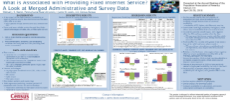
An official website of the United States government
Here’s how you know
Official websites use .gov
A .gov website belongs to an official government organization in the United States.
Secure .gov websites use HTTPS
A lock (
) or https:// means you’ve safely connected to the .gov website. Share sensitive information only on official, secure websites.
-
//
- Census.gov /
- Library /
- Census Working Papers /
- What is Associated with Providing Fixed Internet Service?
What is Associated with Providing Fixed Internet Service? A Look at Merged Administrative and Survey Data
What is Associated with Providing Fixed Internet Service? A Look at Merged Administrative and Survey Data
Introduction
The digital divide continues to be an issue in the U.S. Most research on the topic has relied on survey data on internet subscriptions, but another aspect is availability, or whether Internet Service Providers (ISPs) offer service to a given area. In this poster, we look closely at internet availability using merged administrative and survey data, including data from the Federal Communications Commission (FCC) Form 477, 2010 Census, and American Community Survey (ACS). We assess availability at the county level, identifying correlates associated with ISPs providing service. We find that, for the average county, the vast majority of the population has high-speed fixed broadband service available, though it remains short of universal availability. Some states have high availability throughout, while others vary from one county to the next. We further find that income has a positive overall impact, with a negative effect for DSL and large positive effect for fiber. The effect for more urban counties is also positive. Relative to the Northeast, other regions have a negative effect on availability, particularly for fiber. Although important, policymakers interested in reducing the digital divide should look beyond the factors of urbanicity and income, and especially at the relevance of geography.
Share
Related Information
WORKING PAPER
Computer and Internet Use Working PapersSome content on this site is available in several different electronic formats. Some of the files may require a plug-in or additional software to view.
 Yes
Yes
 No
NoComments or suggestions?


Top

